History
The town of Montefiascone, or, more specifically, the Rocca di Montefiascone, had long been [4] the official residence of the Rector of the Patrimony of Saint Peter, and, whenever a pope visited, of the pope as well. [5]
Pope Urban V had stayed at Montefiascone during his journey from Avignon to Rome, and was greatly impressed by the loyalty and affection of the inhabitants toward himself and his predecessors. The Pope held a consistory for the creation of new cardinals at Montefiascone on 22 September 1368. He named six Frenchmen, a Roman, and an Englishman (Simon de Langham). [6]
The diocese of Montefiascone was erected by Pope Urban V by the papal bull, Cum Illius of 31 August 1369. He appointed the church of S. Margarita to serve as its cathedral, and he installed in it a Chapter composed of two dignities (the Dean and the Sacristan) and eight Canons with prebends. The Dean was to be elected by the Chapter and installed by the bishop, but the other offices were to be filled by appointment by the bishop. The territory for the diocese was taken from the diocese of Bagnoregio, and any properties or rights within that territory which belonged to the bishops of Bagnoregio, Castro, Orvieto, Viterbo or Tuscano were assigned to the bishop of Montefiascone. [7]
Pope Urban held another consistory for the creation of new cardinals at Montefiascone on 7 June 1370. Two cardinals were named, one a Florentine and the other from Rodez in France. [8] He departed from Montefiascone for Avignon on 26 August 1370, where he died on 19 December 1370. [9]
New diocese
Its first bishop was the French Augustinian Pierre d'Anguiscen, appointed in 1376. [10] In 1378, when the Western Schism began, Bishop Pierre became a partisan of Clement VII (Avignon Obedience), and he was therefore deposed by Urban VI (Roman Obedience).
On 5 December 1435, the diocese of Montefiascone was united with the diocese of Corneto in the person of the bishop; that is the bishop of Montefiascone was also at the same time the bishop of Corneto, with each diocese retaining its own institutional integrity. [11] The union continued until, in 1854, Corneto became a part of the diocese of Civitavecchia.
In 1483, Bishop Domenico della Rovere laid the cornerstone for the new cathedral of S. Margarita in Montefiascone, and in his Last Will and Testament in 1501 he left money to continue the work, which had barely reached the level of the main floor of the church at the time of his death. [12]
Synods
Cardinal Marcantonio Barbarigo (1687–1706) held a diocesan synod in the cathedral of Montefiascone on 1–3 June 1692. [13] Bishop Lodivio Zacchia held a diocesan synod in 1622. [14] Cardinal Jean-Siffrein Maury (1794–1816) held a diocesan synod. [15] Bishop Sebastiano Pompilio Bonaventura (1706–1734) presided over a diocesan synod on 16–18 June 1710. [16]
The erection of the diocesan seminary for Corneto and Montefiascone was the work of Cardinal Marcantonio Barbarigo. [17]
End of the diocese
By the middle of 1986, papal policy in the selection of bishops had concentrated in the person of Bishop Luigi Boccadoro: the Diocese of Viterbo e Tuscania, the diocese of Acquapendente (since 1951), the diocese of Montefiascone (since 1951), and the Administratorship of the diocese of Bagnoregio (since 1971); he was also the Abbot Commendatory of Monte Cimino. On 30 September 1986 Pope John Paul II moved to consolidate these several small dioceses by suppressing them and uniting their territories [18] into the diocese of Viterbo e Tuscania, whose name was changed to the Diocese of Viterbo. [19] The diocese of Montefiascone ceased to exist as a territorial circumscription.

The Archdiocese of Ancona–Osimo is a Latin Church ecclesiastical territory and metropolitan see of the Catholic Church in the Marche region of Italy.

The Archdiocese of Capua is a Latin diocese of the Catholic Church in Capua, in Campania, Italy, but its archbishop no longer holds metropolitan rank and has no ecclesiastical province. Since 1979, it is a suffragan of the Archdiocese of Napoli, i.e. no longer has its own ecclesiastical province nor metropolitan status.

The Diocese of Nardò-Gallipoli is a Latin diocese of the Catholic Church in southern Italy. It is a suffragan of the Archdiocese of Lecce.

The Archdiocese of Benevento is a Latin archdiocese of the Catholic Church. It currently has five suffragan dioceses: the diocese of Ariano Irpino-Lacedonia, the diocese of Avellino, the diocese of Cerreto Sannita-Telese-Sant'Agata de' Goti, the Territorial Abbey of Montevergine, and the archdiocese of Sant'Angelo dei Lombardi-Conza-Nusco-Bisaccia.

The Diocese of Rieti is a Latin Church ecclesiastical territory or diocese of the Catholic Church in Italy. It is immediately exempt to the Holy See. Its cathedra is in St. Mary Cathedral in the episcopal see of Rieti.

The diocese of Cervia was a Roman Catholic diocese in Emilia-Romagna. The diocese was a suffragan of the Archdiocese of Ravenna. In 1947, it merged with the archdiocese of Ravenna to form the Archdiocese of Ravenna-Cervia.

The Diocese of Recanati was a Roman Catholic diocese in Italy. It was founded in 1240 by Pope Gregory IX.

The Suburbicarian Diocese of Velletri–Segni is one of the Latin suburbicarian dioceses, Catholic dioceses in Italy close to Rome with a special status and a cardinal bishop, the bishop of Velletri–Segni. Historically, the see of Velletri was combined with the see of Ostia from 1060 to 1914.

The Diocese of Nocera Umbra was a Catholic diocese in Umbria, Italy.
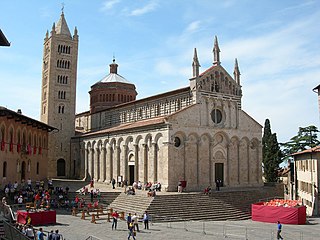
The Diocese of Massa Marittima-Piombino is a Latin Church diocese of the Catholic Church in Tuscany, central Italy. It was known as Diocese of Massa Marittima before 1978. Up until 1458, it was a suffragan of the archdiocese of Pisa; since 1458, it has been a suffragan of the Archdiocese of Siena. The territory of the diocese includes the islands of Elba and Pianosa, and Capraia.

The Diocese of Orvieto-Todi is a Latin Church ecclesiastical territory or diocese of the Catholic Church in central Italy. It was created in 1986 when the historical Diocese of Orvieto was united to the Diocese of Todi. The Diocese of Orvieto-Todi is immediately exempt to the Holy See and not part of any ecclesiastical province.

The Diocese of Viterbo is a Latin Church ecclesiastical territory or diocese of the Catholic Church in central Italy. From the 12th century, the official name of the diocese was the Diocese of Viterbo e Tuscania. In 1986, several dioceses were combined, and the title was changed to "Diocese of Viterbo, Acquapendente, Bagnoregio, Montefiascone, Tuscania and San Martino al Monte Cimino"; in 1991 the name was shortened to "Diocese of Viterbo".
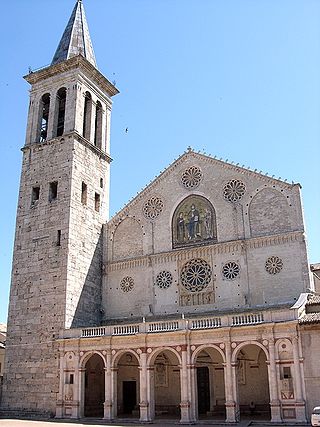
The Archdiocese of Spoleto-Norcia is a Latin Church ecclesiastical territory or archdiocese of the Catholic Church in Italy. Historically, it was the Diocese of Spoleto. Elevated to the status of an archdiocese since 1821, it is a non-metropolitan see and is immediately exempt to the Holy See.

The Diocese of Foligno is a Latin Church ecclesiastical territory or diocese of the Catholic Church in Umbria, Italy. It is a suffragan diocese in the ecclesiastical province of the metropolitan Archdiocese of Perugia-Città della Pieve.
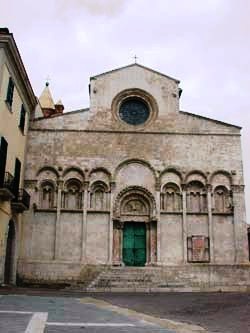
The Diocese of Termoli-Larino is a Latin Church diocese of the Catholic Church situated in the province of Campobasso, region of Molise. The commune of Termoli is an important regional seaport. The diocese has existed in its current configuration since 1986, when the diocese of Larino was suppressed and added to its territory. It is a suffragan of the archdiocese of Campobasso-Boiano.

The Diocese of San Severo is a Latin diocese of the Catholic Church in Apulia. It is a suffragan of the Archdiocese of Foggia-Bovino.
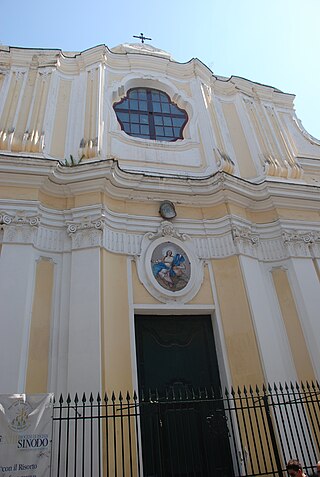
The Diocese of Ischia is a Latin diocese of the Catholic Church in Campania, southern Italy. It is a suffragan of the Archdiocese of Naples. The diocese comprises the entire island of Ischia, which contains seven communes divided into two circumscriptions. In 1743, the population was about 4,000. The city of Ischia constituted one single parish, with two religious houses of men and one of women. In 2018, the population of the town of Ischia was 20,118.
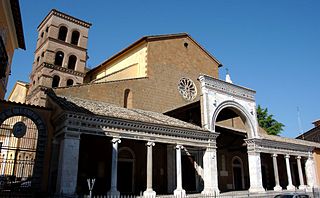
The Diocese of Civita Castellana is a Latin Church ecclesiastical territory or diocese of the Catholic Church in Latium, central Italy. It has existed in the current form since 1986, when the Diocese of Nepi e Sutri was united into the Diocese of Civita Castellana, Orte e Gallese. The Diocese of Gallese had been added to the Dioceses of Civita Castellana and Orte in 1805. The name of the diocese was shortened in 1991, in accordance with Vatican policies. The diocese of Civita Castellana is immediately exempt to the Holy See.

The Italian Roman Catholic diocese of Acquapendente was an ecclesiastical territory in Lazio. The seat of the bishop was in the cathedral of Acquapendente, dedicated to the Holy Sepulchre. The diocese was established in 1649, when it was created in the place of the suppressed diocese of Castro. In 1986, along with other dioceses, it was merged into the diocese of Viterbo, Acquapendente, Bagnoregio, Montefiascone, Tuscania e San Martino al Monte Cimino.

The Diocese of Guardialfiera or Diocese of Guardia was a Roman Catholic diocese in Italy. The diocese was established in the second half of the 11th century, with seat of the diocese was located in the city of Guardialfiera in the Province of Campobasso in the region of Molise. In 1818, the diocese was suppressed, and its ecclesiastical territory was assigned to the Diocese of Termoli.




















